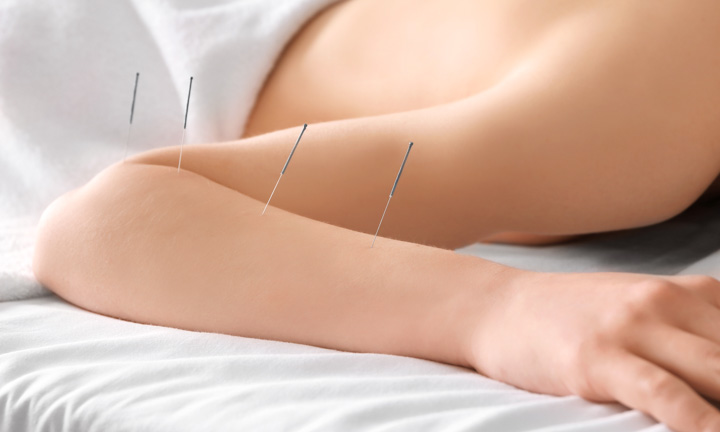Acupuncture is found effective for the treatment of paralysis caused by a stroke. Researches tested the Shujintongluo acupuncture protocol for the treatment of hemiplegia, a type of stroke affecting one side of the body. The addition of acupuncture to standard drug therapy following an acute cerebral infarction increased the positive patient outcome rate by 11.77%.
A randomized clinical trial of 68 patients examined results in two groups. One group received standard drug therapy and the other group received standard drug therapy plus acupuncture. The drug therapy only group had a total effective rate of 70.59%. The group receiving drug therapy plus acupuncture had an 82.36% total effective rate.
One of the more important results measured in the study was the recovery rate, defined as a disability rank of level 0 and the NHISS (National Institutes of Health Stroke Scale/Score) improvement rate of 91% – 100%. The group receiving acupuncture plus drugs had a 29.41% recovery rate and the drugs only group had a 20.59% recovery rate. Another important result was the significantly effective rate, defined as a disability rank of level 1 – 3 and an NHISS improvement of 46% – 90%. The acupuncture plus drugs group had a 38.24% rate and the drugs only group had a 35.29% rate.
Fugl-Meyer Assessment of Sensorimotor Recovery (FMA) and Modified Barthel Index Score (MBI) were significantly better in the group receiving acupuncture. This includes improvements in motor functioning, sensory abilities, balance, joint functioning, bowel and bladder control, ability to eat, walking, transfers, dressing, climbing stairs, and bathing. The acupuncture plus drugs group had an FMA score of 38.65 and an MBI of 56.46. The drugs only group scored an FMA of 28.24 and an MBI of 47.36.
The Shujintongluo (alleviating muscle rigidity and promoting blood circulation) protocol is based on several Traditional Chinese Medicine (TCM) principles: alleviate blood stasis, enhance cerebral circulation, promote blood circulation to benefit brain cells, reduce brain tissue damage. Some of the goals associated with this protocol are to restore the function of facial nerves, motor coordination of the limbs, and language abilities.
Patients were admitted to the study at the Loudi Convalescent Hospital of Hunan. The average age was 65.3 (±6.4) years. Eight acupuncture treatments comprised one course of care and all patients received three courses of acupuncture treatments. Total treatment time per each acupuncture session ranged from 35 – 40 minutes. Acupuncture points used in the study were selected from the following list per each patient’s specific needs:
BL60 (Kunlun)
GB32 (Zhongdu)
GB34 (Yanglingquan)
KD3 (Taixi)
LI10 (Shousanli)
LI11 (Quchi)
LI14 (Binao)
LI15 (Jianyu)
LI4 (Hegu)
LU5 (Chize)
LV3 (Taichong)
PC3 (Quze)
PC6 (Neiguan)
SP10 (Xuehai)
SP6 (Sanyinjiao)
SP9 (Yinlingquan)
ST32 (Futu)
ST36 (Zusanli)
TB10 (Tianjing)
TB5 (Waiguan)
Based on the research data, the investigators conclude that early intervention with acupuncture improves patient outcomes for patients with hemiplegia due to an acute cerebral infarction. Pronounced improvements in motor abilities and daily living activities in the acupuncture group were standouts in this investigation.

Li Xueyan and Zhang Liang confirm these findings in their laboratory experiment. The results indicate that scalp acupuncture is effective for stimulating neurologic repair and reducing cerebral edema caused by an intracerebral hemorrhage. Motor improvements included improved standing and bending in laboratory rats. Biochemical analysis confirms that acupuncture regulates expression of MMP-9 (matrix metallopeptidase), an enzyme that breaks down extracellular matrix that is involved in tissue remodeling. To achieve this result, acupoint Baihui (GV20) was connected to Xuanli (GB6) using the threading technique.
In related research, Taipei Medical University researchers (Huang et al.) confirm that acupuncture benefits stroke patients. Hemiplegic stroke patients patients receiving acupuncture had significantly greater positive patient outcome rates than a control group. A total of 66 patients were randomly assigned to two groups for a total sample size of 132 participants. Postural assessment scales were measured for both static and dynamic balance values. The results demonstrate that acupuncture significantly improves static balance when added to the rehabilitation phase of treatment for hemiplegic stroke patients with a low Brunnstrom (Br) stage (a measure of motor activity including flaccidity, synergy, voluntary movements, spasticity, complex movements, individual joint movements, and the restoration of normal function).
The results indicate that integration of acupuncture into usual care facilities improves patient outcomes. Patients in the USA rarely receive this level of care; however, many hospitals and in-patient facilities in China and Japan provide acupuncture as an essential therapeutic modality after a stroke. In the vast majority of facilities in the USA, a licensed acupuncturist is not permitted to provide acupuncture therapy to post-stroke patients. Unfortunately, precious time is wasted if the services are not provided with rapidity. The greatest results are typically achieved within the first week after a stroke with excellent results often possible up to three weeks after a stroke. After this timeframe, results are often achieved at a slower pace.
References
Li YH. (2016). Treating Early Hemiplegia Following Acute Cerebral Infraction by Acupuncture Plus Rehabilitation Therapy.Clinical Journal of Chinese Medicine.2016,8(5):13-15.
Huang CJ,Qi F. (2014). Clinical Observation of Treating Early Hemiplegia Following Acute Cerebral Infraction by Acupuncture Therapy.China Practical Medical.2014,9(15):249-250.
Yang CG. (2013).Clinical Observation of 263 Cases of Treating Early Hemiplegia Following Acute Cerebral Infraction by Acupuncture.Chinese Journal of Practical Nervous Diseases. 2013,16(18):78-79.
Zhang X, Jiang JC.(2011). Treating Early Hemiplegia.Chinese Journal Of Integrative Medicine On Cardio/Cerebrovascular Disease.2011,1(5):274-275.
Huang CJ,Qi F.(2014). Clinical Observation of Treating Early Hemiplegia Following Acute Cerebral Infraction by Acupuncture Therapy.China Practical Medical.2014,9(15):249-250.
Li Xueyan, Zhang Liang. Experimental Study on Neuroprotective Effects of Acupuncture and Intervention on MMP-9 Expression in Rats with Intracerebral Hemorrhage, Information on Traditional Chinese Medicine, 2015 (4).

![Diseases, Symptoms, tcm, [tcmwindow.com]](/uploadFile/adImg/2015/11/11/f5cbfcc0-4df5-4646-9b9a-f316651a0199.jpg)





